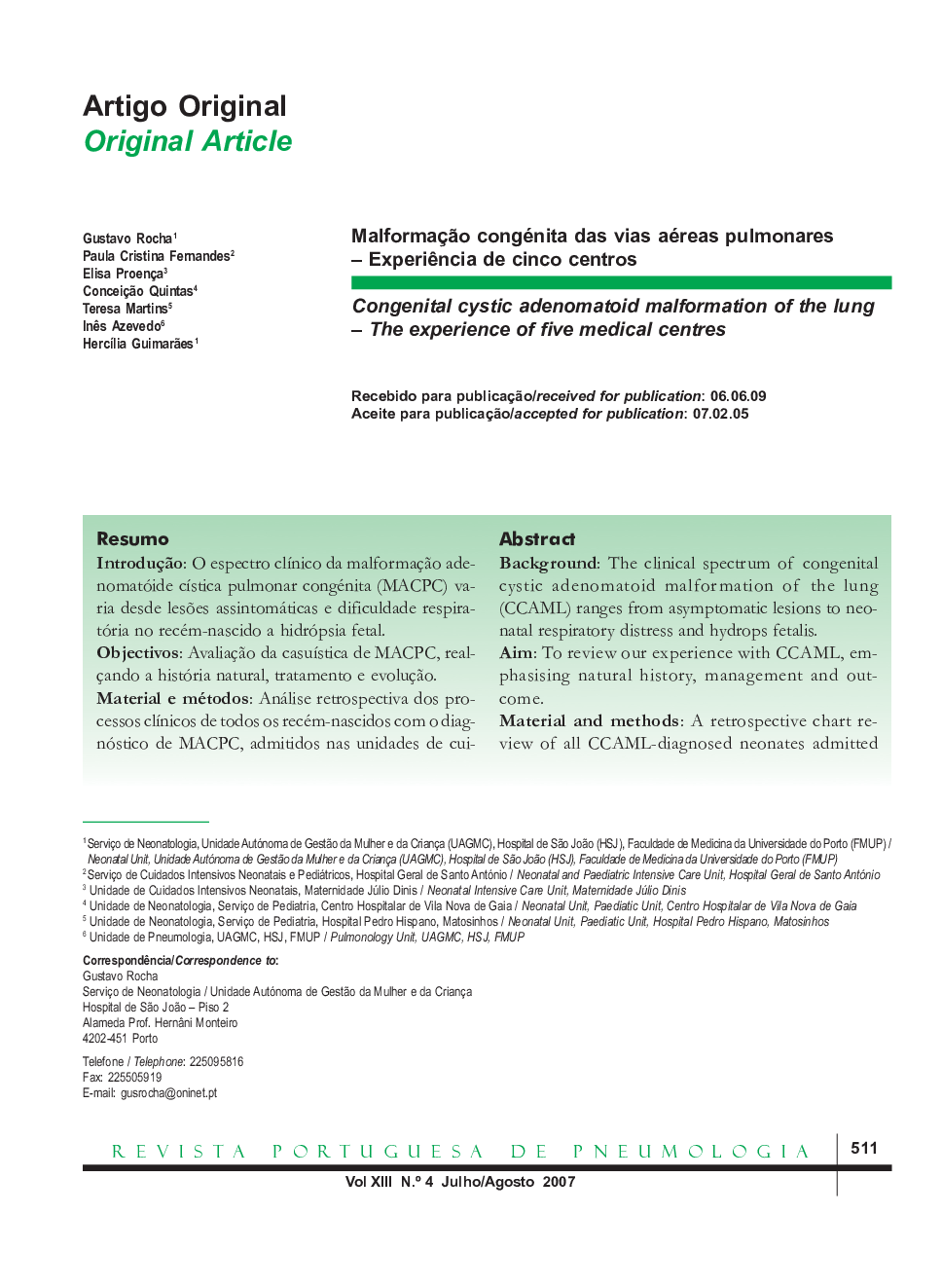| Article ID | Journal | Published Year | Pages | File Type |
|---|---|---|---|---|
| 4214366 | Revista Portuguesa de Pneumologia | 2007 | 13 Pages |
ResumoIntrodução: O espectro clínico da malformação adenomatóide cística pulmonar congénita (MACPC) va-ria desde lesões assintomáticas e dificuldade respiratória no recém-nascido a hidrópsia fetal.Objectivos: Avaliação da casuística de MACPC, real-çando a história natural, tratamento e evolução.Material e métodos: Análise retrospectiva dos processos clínicos de todos os recém-nascidos com o diagnóstico de MACPC, admitidos nas unidades de cui-dados intensivos neonatais de cinco centros terciários do Norte de Portugal, entre 1996 e 2005.Resultados: Foram identificados 15 recém-nascidos, 9 F/6 M, peso ao nascimento 3100 g (645-3975), idade gestacional de 38 semanas (24-40). A incidên-cia de MACPC foi de 1:9300 nascimentos. Onze (73%) recém-nascidos apresentaram diagnóstico pré-natal de lesão pulmonar cística pelas 22 semanas (19-30). Esta ocorreu no hemitórax direito em seis (40%) casos e no lado esquerdo em 9 (60%). Foi documentada regressão in utero da lesão em dois casos. Foi necessária intervenção ante-natal (pleu-rocentese e colocação de derivação toraco-amnió-tica) num feto com hidrópsia fetal. Ao nascimento, cinco recém-nascidos apresentaram radiografia de tórax dentro da normalidade, sendo a tomografia axial computorizada diagnóstica da lesão. Três (20%) recém-nascidos tornaram-se sintomáticos durante o período neonatal (dificuldade respiratória) e um (7%) após o período neonatal (pneumotórax espon-tâneo). Dois (13%) faleceram. Seis (40%) doentes foram submetidos a toracotomia e exérese da lesão. O estudo anatomopatológico demonstrou acha-dos definitivos de MACPC (classificação de Stoker: tipo I = 4; tipo II = 1; tipo III = 2). Oito (53%) crianças mantiveram-se assintomáticas e permane-cem em vigilância clínica.Conclusões: A MACPC com diagnóstico pré-natal tem bom prognóstico na ausência de sofrimento fetal; uma radiografia de tórax sem alterações ao nascimento não exclui MACPC; o tratamento da lesão assintomática é controverso; a cirurgia está indicada devido à baixa morbilidade e possibilidade de preven-ção de complicações tardias, como a degenerescência maligna.Rev Port Pneumol 2007; XIII (4): 511-523
Background: The clinical spectrum of congenital cystic adenomatoid malformation of the lung (CCAML) ranges from asymptomatic lesions to neonatal respiratory distress and hydrops fetalis.Aim: To review our experience with CCAML, emphasising natural history, management and out-come.Material and methods: A retrospective chart review of all CCAML-diagnosed neonates admitted to the neonatal intensive care units of five tertiary medical centres in the north of Portugal between 1996 and 2005.Results: Fifteen neonates with CCAML were identified, 9 F/6 M, birth weight 3100 g (645-3975), gestational age 38 weeks (24-40). The incidence of CCAML was 1: 9300 births. There were 11 (73%) cases of cystic lung lesion diagnosed during pregnancy, median age 22 weeks (19-30). The lesion was right sided in six (40%) and left sided in nine (60%) cases. In utero spontaneous regression of the lesion was observed in two cases. Antenatal intervention (pleurocentesis and thoracoamniotic shunting) was performed in one foetus with impending hydrops. Normal lung radiographic findings at birth were present in five cases, with an abnormal CT scan. Three (20%) neonates became symptomatic during the neonatal period (respiratory distress) and one (70%) after the neonatal period (spontaneous pneu-mothorax). Two neonates (13%) died. Six (40%) patients underwent thoracotomy and appropriate excisional surgery. Histological examination showed definitive features of CCAML (Stocker classification: type I = 4; type II = 1; type III = 2). Eight (53%) patients remain asymptomatic and did not undergo surgery.Conclusions: Antenatally diagnosed CCAML has a good prognosis in the absence of severe foetal distress; normal radiographic findings at birth do not rule out CCAML; treatment of asymptomatic CCAML is controversial; surgery may be advocated because of its low morbidity and the prevention of late complications such as malignancy.Rev Port Pneumol 2007; XIII (4): 495-523
